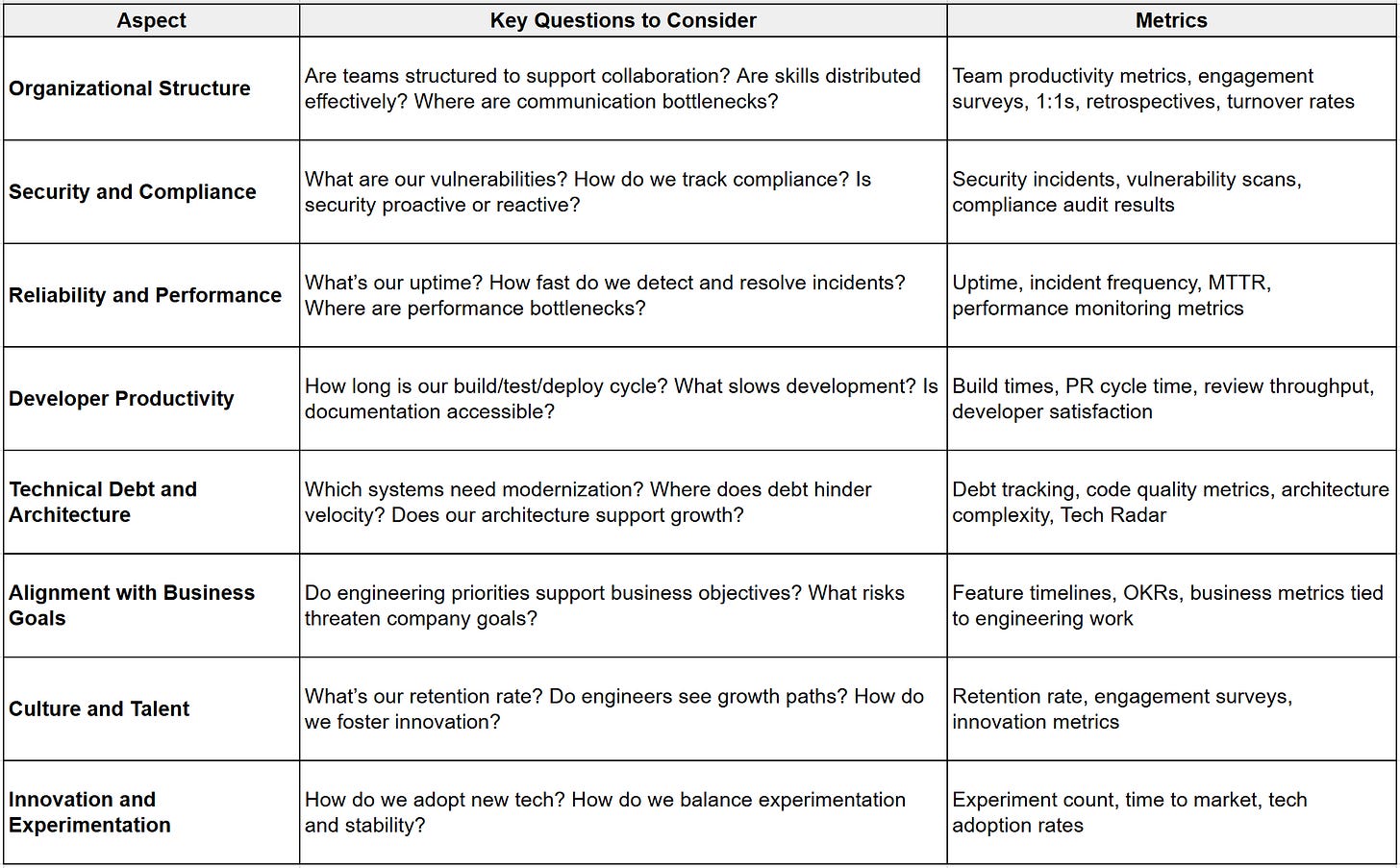This article is the first in a multipart series, "What’s Your Strategy?" - A Guide to Developing an Engineering Strategy. Today we zoom in on the Diagnosis phase, a critical part of any effective strategy
Why Software Engineering Needs a Strategy
In today’s fast-evolving technology landscape, engineering organizations grapple with unprecedented complexity. Teams are pulled between the demands of innovation and the realities of maintenance, while business stakeholders expect both rapid delivery and rock-solid reliability—a high-stakes balancing act that’s nearly impossible without a clear plan.
An effective engineering strategy serves as the essential framework for aligning teams and making coordinated decisions. It sets clear priorities, directs resource allocation, and establishes decision-making boundaries. Above all, it ensures engineering efforts support broader business objectives, driving organizational success.
As Richard Rumelt writes in Good Strategy/Bad Strategy:
“A good strategy acknowledges the challenges being faced and provides an approach to overcome them. The greater the challenge, the more a good strategy focuses and coordinates efforts to achieve a powerful competitive punch or problem-solving effect.”
But where does this clarity begin? Not with solutions or roadmaps, but with a critical first step: diagnosis.
The Foundation of Strategy: Diagnosis
Diagnosis is the bedrock of any effective engineering strategy.
Weak strategies often start with vague ambitions—broad goals like “We need to innovate faster” or “We must become more agile”—without pinpointing the specific obstacles holding progress back. In contrast, a powerful strategy begins with a thorough assessment, naming the challenges that stand between your current reality and your goals.
Michael Porter captures this succinctly:
“The essence of strategy is choosing what not to do. Strategy is about making choices, trade-offs; it’s about deliberately choosing to be different.”
These choices, however, are only meaningful when rooted in reality—a reality uncovered through diagnosis.
The Anatomy of Effective Diagnosis
A strong diagnosis goes beyond listing complaints or aspirations. It’s a deliberate process of collecting and analyzing evidence to reveal the true barriers to progress.
When I first tried crafting a strategy, I began simply: I described the status quo. I outlined the engineering context—our people, technical challenges, and the commercial landscape—along with our existing approaches and actions. It wasn’t revolutionary, but it was a vital starting point. By making the implicit explicit, I laid the groundwork for a diagnosis and identified areas to explore further. Here’s how to build on that foundation with a comprehensive, actionable diagnosis:
1. Gather Diverse Perspectives
A robust diagnosis pulls from multiple vantage points. As part of this process, start with the business context—your roadmap, competitive landscape, and financial priorities. Add quantitative insights from developer productivity metrics and cultural surveys. Then, weave in qualitative challenges surfaced through leadership discussions, team meetings, and 1:1s.
Will Larson, in An Engineering Executive Primer, suggests seeking “mini diagnoses” from Staff Engineers and Engineering Managers across different domains, rather than relying solely on your own lens. Cross-functional partners can also shed light on their expectations and perceived gaps in engineering performance. Domain experts—think DevOps, Product Engineering, or Support—often highlight collaboration opportunities you might otherwise miss.
This diversity of input guards against blind spots and fosters alignment around shared challenges.
2. Examine Multiple Dimensions
Effective diagnosis assesses the full spectrum of engineering health. The table below offers a framework for exploring these dimensions, blending quantitative data and qualitative insights to reflect both measurable outcomes and lived experiences. If you lack certain metrics, don’t be surprised—part of your strategy might involve establishing ways to gather them.
3. Prioritize Based on Impact
Your diagnosis will uncover a mix of loud problems, quiet risks, and hidden blind spots. Not every issue warrants equal focus. Prioritize challenges based on their potential to drive meaningful impact—consider their alignment with business goals, the feasibility of solutions, and the resources required.
For startups chasing product-market fit, time to market and innovation might top the list. For established enterprises, security, compliance, and technical debt often take precedence. This step ensures your strategy targets what matters most.
4. Connect to Broader Context
Finally, situate engineering challenges within the wider business and market landscape:
How do development timelines shape competitive positioning?
How does system reliability affect customer retention?
How do architecture choices enable—or limit—market expansion?
This framing helps executives see why tackling specific engineering issues is vital to overall success, bridging the gap between technical and business priorities.
5. Create alignment
When the priority challenges to address have started emerging from the diagnosis, it’s critical to go back to the people you sought initial diagnosis from to bring their awareness to the bigger picture. A good strategy will never please everyone, however if there is alignment on what challenges need to be addressed to reach the goals, you are more likely to get buy-in on the resulting policies.
Without a deliberate strategy, engineering teams risk slipping into reactive mode—chasing crises, bowing to the loudest voices, or adopting trendy technologies without clear purpose. This breeds misaligned priorities, inconsistent architectures, and frustrated teams pulling in different directions.
A thorough diagnosis cuts through the noise. It moves you past vague goals to confront specific obstacles head-on, distinguishing root causes from surface symptoms. But here’s a word of caution: resist the urge to leap at the first issue that catches your eye. That shiny problem might feel urgent, but acting too soon can pull you off course before the full picture emerges.
Instead, let diagnosis bring clarity to your strategic thinking. It’s your foundation for building alignment: when leaders, executives, and teams share a clear view of the challenges, they can rally behind a unified response, translating insight into action through focused policies and concrete steps.
Stay tuned for the sequel where we’ll delve into how to build guiding policies based on this diagnosis!


